Easter Layer Cake 2017
Easter layer cake with mixed spice, almond buttercream, pistachio ganache and filled eggs
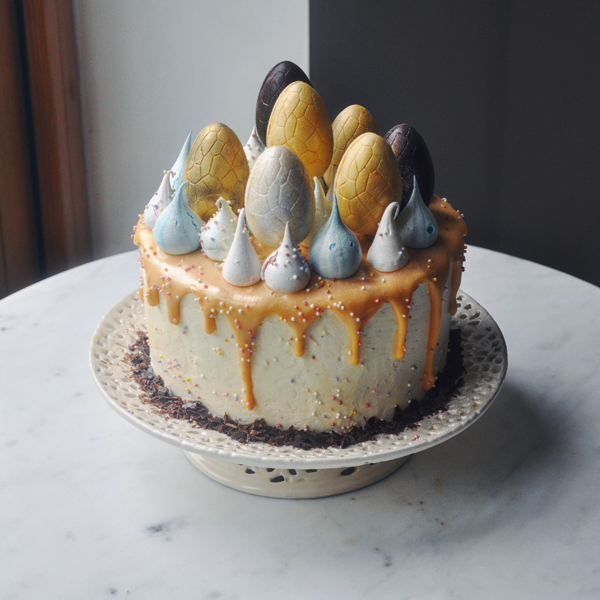
Making actual, proper cakes is something I don't do very often. You guys that do this day in day out are legendary; it's hard work!
A few weeks ago, I made a lemon version of this for Mother's day (are we really already at Easter?), so I thought I'd do it again with an Easter twist. I've provided a list of alternative ingredients at the bottom incase you want to make the lemon version instead.
Ingredients (Makes 1 individual cake, serving 8 people with lots of meringues left for the chef)
For the cakes (you'll need to make 2 and split them both)
- 350g Self-raising flour
- 350g Unsalted butter
- 350g Golden caster sugar
- 6 Whole large eggs
- 10g Baking powder (about 2 teaspoons)
- 10g Mixed spice (about 2 teaspoons)
For the white chocolate pistachio ganache
- 100g Shelled green pistachios or 2 tablespoons of pistachio butter
- 300g Whipping cream
- 300g White chocolate coverture (chips or callets if possible - this is what I'm using at the moment)
For the almond buttercream
- 120g Egg whites
- 200g Caster sugar
- 250g Unsalted butter
- 1 teaspoon of a strong almond extract
For the white chocolate drip ganache
- 150g Whipping cream
- 130g White chocolate coverture
- 20g Cocoa butter
- Paste or powder food colouring (I've used Wilton Ivory here)
For the meringues
- 75g egg whites
- 150g caster sugar
- Blue paste food colouring or any you feel like
Filled Eggs
For the tempered dark chocolate
- 250g Dark chocolate (at least 55% - this is what I've used here)
For the tempered white chocolate
- 250g White chocolate coverture
White chocolate passion fruit ganache filling
- 150g White chocolate coverture
- 150g Whipping cream
- 15g to 25g Passion fruit powder to your own taste (This one from Sous Chef is especially good)
Dark chocolate Manhattan ganache filling
- 150g Dark chocolate (at least 55%)
- 100g Whipping cream
- 30g Bourbon (I've used Four Roses Small Batch)
- 20g Sweet Vermouth (I've used Antica Formula)
- A few dashes of Angostura or other bitters
Other bits
- Gold and silver edible spray
- Dark rum for soaking into the cake layers
Equipment
- 18cm diameter, 8cm tall cake tin
- Plastic or other small egg mould
- Disposable piping bags and nozzles
- Silicone mat
- Stand mixer
- Sieve
- Stick blender
Make the cakes
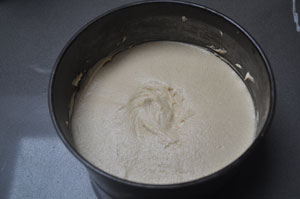
Pre-heat your oven to 170C, and line two (or one if you have to do it twice in the same tin like me) with baking parchment. Spray the insides of your tin and parchment with spray oil, cake spray or lightly butter the surfaces.
Place the butter in your stand mixer with the sugar and cream until the butter is soft. Sieve in the flour and baking powder, then add the eggs and mixed spice. Mix for a few minutes until you get a nice smooth mixture.
Pour half the mix into each cake tin, then level off with a spatula and bake for 35 to 40 minutes (until a chopstick inserted into the middle of the cake comes out clean).
Remove from the oven, and let cool for 10 minutes; then remove from the tins onto a wire rack and leave to cool completely.
Make the pistachio ganache (for both inside the cakes and one of the filled eggs)
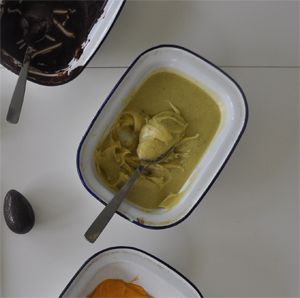
If you're using shop-bought pistachio butter, skip this first section.
Pre-heat your oven to 200C, then spread the pistachios out on a tray and toast for 10 minutes
Pour the nuts into a food processor, and blend for 10 minutes until the oils are released and the nuts turn into butter
Place the double cream in a heavy bottomed pot with around two tablespoons of the pistachio butter and mix with a spatula until combined.
Put the while chocolate into a heat-proof bowl (and chop if you're not using callets).
Heat the cream gently until it starts to bubble, then immediately pour over the white chocolate. Leave it for two or three minutes, then blend with your stick blender until all the white chocolate has melted. Finally, and it should still be warm at this point, add the unsalted butter and blend again.
Pour into a tray, cover with cling film and let set in the fridge for an hour.
Make the passion fruit ganache (for inside one type of filled eggs)
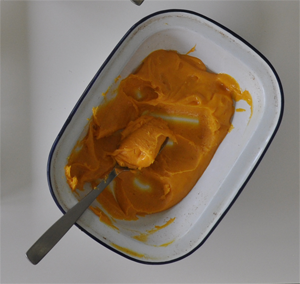
Place the double cream in a heavy bottomed pot and add the passion fruit powder. Stir to combine (note - you can use fresh passion fruit juice here, but it's just not as intense. If you use it, reduce the amount of cream by the weight of juice used)
Put the white chocolate into a heat-proof bowl (and chop if you're not using callets).
Heat the cream gently until it starts to bubble, then immediately pour over the white chocolate. Leave it for two or three minutes, then blend with your stick blender until all the white chocolate has melted. Finally, and it should still be warm at this point, add the unsalted butter and blend again.
Pour into a tray, cover with cling film and let set in the fridge for an hour.
Make the Manhattan ganache (for inside one type of filled eggs)

Place the double cream in a heavy bottomed pot with the vermouth, bourbon and bitters. Stir to combine.
Put the dark chocolate into a heat-proof bowl (and chop if you're not using callets).
Heat the cream gently until it starts to bubble, then immediately pour over the dark chocolate. Leave it for two or three minutes, then blend with your stick blender until all the chocolate has melted. Finally, and it should still be warm at this point, add the unsalted butter and blend again.
Pour into a tray, cover with cling film and let set in the fridge for an hour.
Temper and make the dark chocolate shells

Prepare a pot of water and place a heatproof bowl over the top. Weigh out your chocolate, then place two thirds into the heatproof bowl and reserve the rest.
Using a thermometer, heat and stir the chocolate until it reads between 45C and 50C.
Immediately remove from the heat, and mix in the remaining third of chocolate (chopped or callets) and stir vigorously until mixed. As you're doing this, take occasional temperature readings - when it hits 31 to 32C it's ready to use. If you dip below, very gently heat again over the bain marie - but don't exceed this temperature. If you're struggling to make the last third of the chocolate melt, use a stick blender to help.
When the chocolate is ready, pour it into the shell mould so that it fills them entirely - the amount given in this recipe is for the type of mould I'm using - you may need more or less.
This part all proper chocolatiers will want to collectively punch me in the face for - place your mould into the freezer for 60 seconds. This will help firm the outside of the chocolate shell.
When time is up, remove and pour the excess chocolate out, leaving a layer of around 5 or 6mm around the outside. Place back into the freezer for 5 minutes.
This time your chocolate should be completely solid - so scrape the edges of the mould with a sharp knife to release the shells (keep any shavings for decoration at the end of the cake), then flip the mould and tap hard on your work surface. If you've got a good temper (the chocolate, not your own demeanour) they should fall straight out. You may need to tap or drop the mould a few times to release them all. Reserve the shells for the next stage.
Temper and make the white chocolate shells
Follow exactly the same process above, except that you should wait until the temperature is 28 to 29C until pouring it into the mould.
Fill the shells
Remove the ganaches from the fridge, and spoon the Manhattan one into the dark shells. Smoothen with a spatula, but leave a little extra over the shell's edge. Press two halves together until some of the ganache leaks out, then take a paper towel and rub the excess off around the edge so that the shells stick together.
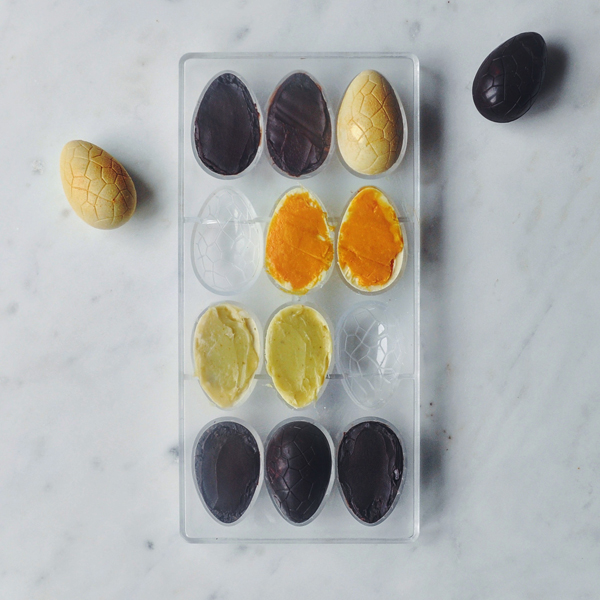
Repeat with the pistachio and passion fruit ganaches - you can mix and match these two between dark and white chocolate if you like; the Manhattan one only works well in the dark shells though!
Reserve the eggs in the fridge
Split and layer up the cake
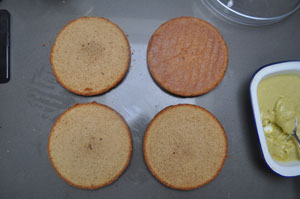
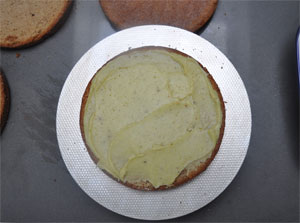
Take each of the two cakes, then cut the top off so that you have an even top and bottom. Split each of these in two, so you end up with 4 pieces of equal height.
Use the bottom of one cooked cake as the base, and the bottom of the other cooked cake as the top so you can really ensure a decent flat surface.
Place your first layer on a board or cake stand, then pour 3 tablespoons of dark rum over the surface as evenly as you can.
Spread around two tablespoons of the pistachio ganache over the cake, then level it up. Repeat with another two layers, then finally place the last layer over the top so you have a 4 layer cake with 3 layers of ganache sandwiched between. Place sin the fridge to firm up.
Make the meringues
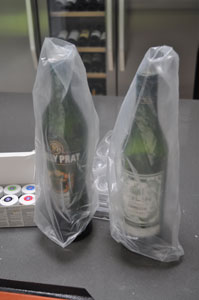
This is the brilliant Meringue Girls technique, which gives a chewy and delicious result.
Heat your oven to 200C, then place the caster sugar into a try lined with baking paper for 7 minutes.
When time's up, reduce your oven 100C.
Place the egg whites in the bowl of your stand mixer and whisk until firm peaks form. Gradually shower in the heated sugar, then keep whisking until the meringue is glossy.
Prepare a tray with a silicone mat, and piping bag with the food colouring - you want to take your piping bag, then turn it inside out, except for a tiny bit where you'll put the piping nozzle. Place this over a tall bottle, then grab your food colouring paste and paint 4 evenly spaced vertical lines from the top to the bottom of the bag. Remove from the bottle, place your piping nozzle in, and invert back the other way.
Fill the piping bag with your meringue, then pat it down with your hands to both remove the excess air and also get the colouring going. Tie, fold or clip the top then cut open the end and push out the nozzle.
Pipe evenly spaced meringues onto the silicone mat, pulling upwards to get a taller meringue. Leave a centimetre or two between each one.
Place in the oven for around 40 minutes
Make the drip ganache
Do this first, as it needs to thicken to exactly the correct consistency, and that can take some time.
Place the cream in a heavy bottomed pot. Weigh the chocolate and cocoa butter into a heat-proof bowl.
Heat the cream until it's bubbling, then pour onto the chocolate. Leave to stand for 2 or 3 minutes, then mix with a spatula or blend with a stick blender. Drop in the paste - I've used Wilton's Ivory colour here. Once completely combined, place in the freezer to firm up.
This is the trickiest part of the recipe; if you've not left it long enough, the ganache will be too runny and simply drip off the cake leaving a mess. If it's too thick it won't drip at all. You want it to be relatively heavy, and closer to fully setting than being liquid. It can take a couple of hours in the freezer - so wait it out, but check regularly. Get on with the buttercream while you're waiting.
Make the buttercream and ice the base cake
Place a pot of water on your hob, and heat until simmering. Weigh the egg whites and sugar into a bowl, then place this over the simmering water. Immediately start to whisk - and I'd recommend a hand-held electric whisk at this point. Keep going until it whips to a stiff peak.
Transfer to your stand mixer bowl, and whisk again. While it's still hot, start dropping the butter in piece by piece until it's all gone. The heat will melt the butter, so it won't cream straight away - but give it 5 or 10 minutes at high speed and you'll end up with a smooth buttercream. Before you stop whisking, add the almond essence.
Finally, ice the cake by plastering the outside and top with buttercream, then placing back in the fridge for 20 minutes. When time's up, remove the cake from the fridge and you'll find the buttercream has firmed up slightly. Begin to smoothen the sides and top with a long spatula. If you've got one of those rotating cake stands, use that by placing the spatula up against the cake and spinning the base instead. You can keep dipping your spatula into warm water if you want to make it really smooth. The top is less important to get totally perfect, as the ganache will cover any minor imperfections.
Place back in the fridge until the drip ganache is ready.
Drip the ganache
When the ganache is just about moving when you spoon it, it's ready. Start to spoon small amounts near the edge; if it starts to drip down the cake all the way to the bottom, it's still not firm enough - so return to the freezer. If it starts to drip and stops somewhere down the buttercream, you're good.
Continue doing this all around the cake using more or less each time so the drips are different lengths.
When you've gone all the way around, use the remaining ganache to fill the top of the cake, then place in the fridge to solidify one last time
To serve
Place a toothpick into the bottom of each egg you're adding to the cake. If you've got / are using gold and silver edible spray, spray them at this stage. Stick 6 or 7 eggs on top at different heights.
Place some meringues around randomly, then finally throw over some hundreds and thousands.
If you kept any of the chocolate scrapings, place these around the bottom of the cake.
Hope you enjoy this one and Happy Easter!
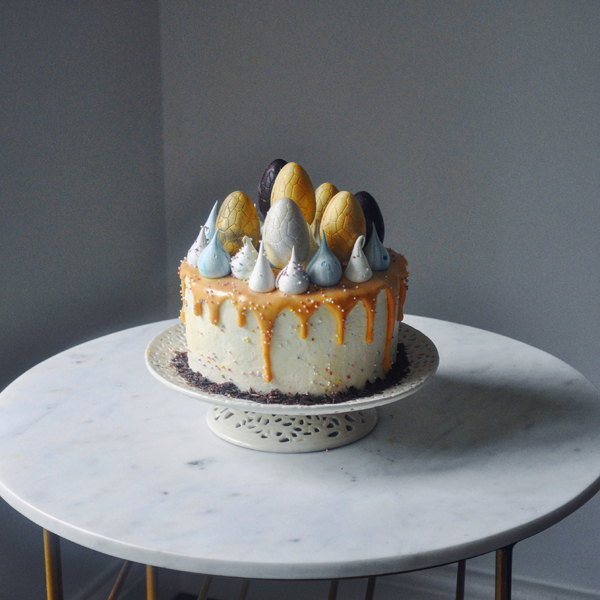
Lemon variation
- Substitute the mixed spice for the zest of two lemons and the juice of half in the cake mix
- When layering, substitute the rum for gin mixed with lemon juice
- When making the buttercream, substitute the almond essence for more lemon zest and a 1/2 teaspoon of vanilla powder or extract
- Instead of the pistachio ganache between the cakes, make or buy lemon curd and spread between each layer. Here's my recipe from way back in post #2
- Instead of the filled eggs, make some lemon macarons filled with curd and whipped cream. Here's one receipe for the shells from post #19
- Substitute out the random colours for yellow!

Seventy Five
A roasted pistachio and rose tartlet to celebrate my Dad's 75th

It was Dad's 75th Birthday this weekend; he's more than double my age, but still insists on balancing ladders on the top of ironing boards, just so he can pick an apple off a tree or destroy a wasps nest. I can only hope to be that able (though perhaps a little less insane) when I get there myself.
When I was young, some of my earliest memories are of my Mum roasting pistachio nuts in the oven, and Dad sitting down eating entire bags of them in one sitting - while somehow managing to stay under 10 stone in weight.
This recipe is a dedication to that memory; a roasted pistachio butter used to flavour sweetened cream, rose crème pâtissière, topped with meringues and another of his favourites - pistachio nougat.
You'll also get some bonus left over pistachio butter for your toast (just add salt or sugar), some meringues and some nougat to have later on.
Ingredients (makes 4 individual tartlets)
For the roasted pistachio butter
- 150g green pistachios (the proper Iranian ones if you can; I get mine from Sous Chef)
For the roasted pistachio cream
- 400g Whipping Cream
- 50g Icing sugar
For the rose crème pâtissière
- 3 large egg yolks
- 250ml whole milk
- 60g caster sugar
- 25g plain or type 45 flour
- 1 to 2 teaspoons of rose flavouring
- Powdered red food colouring (optional - you won't see it until you cut the tart open)
For the tart cases
- 250g type 45 flour [Buy] (or just plain if you don't have any)
- 140g unsalted butter (softened)
- 1 large egg
- 1 large egg yolk
- 40g ground almonds
- 90g icing sugar
- 1/2tsp almond essence
For the rose meringues
- 2 Large Egg Whites
- 65g Icing Sugar
- 65g Caster Sugar
- 1 teaspoon of rose flavouring
- Some crushed pistachio nuts and rose petals for decoration
For the pistachio nougat
- 210g Caster Sugar
- 50g Liquid Glucose
- 60g Honey
- 35g Egg Whites
- 50g Green Pistachio nuts
To finish
- Crushed green pistachios
- Reserved pistachio butter
- Rose petals
Equipment required
- 10cm tart rings
- 9cm circular cutter
- Stand mixer
- Thermometer
- Food processor
- Silicone mat
- Baking beans
- 30cm metal baking tray
- Plastic piping bag and large piping head
Make the roasted pistachio butter
 Turn your oven on to 170°C.
Turn your oven on to 170°C.
Weigh out the pistachio nuts onto a baking tray and, when up to temperature, place in the oven for 8 minutes.
When time's up, remove from the oven and pour into a food processor. Leave to blend for 10 minutes while still hot. You'll see the nuts crush, then get oily, solidify and finally blend into liquid. Stop and scrape down the bowl of your machine when it's liquid to make sure everything has been turned into a delicious pistachio paste.
Decant from the bowl and reserve. Once it's cool, place in the fridge. You can taste it if you like - but I promise it'll be so claggy you won't be able to speak; so maybe don't do that. Protip: If you're having the leftovers on toast, mix in some sugar or salt and that will reduce the sticky mouthfeel.
Make the pistachio cream discs
 When the pistachio butter has cooled, line a high-sided (at least 1/2 inch) baking tray with some greaseproof paper and give it a quick spritz of baking or 1 cal spray.
When the pistachio butter has cooled, line a high-sided (at least 1/2 inch) baking tray with some greaseproof paper and give it a quick spritz of baking or 1 cal spray.
Take the cream and whip with an electric whisk until soft peaks have formed. Shower in the icing sugar and whip again until almost firm.
Next, pour in about 2/3 of the pistachio butter. Whip for a couple of seconds more to blend - just don't overdo it and whip the cream too much; it should hold a shape and not be pourable. If you're nervous about over whipping, fold the pistachio in with a spatula instead.
Spoon the lot into a baking tray, then level off with an angled spatula. Try to get it as level as possible, then place in the freezer to solidify for about an hour.
The rose crème pâtissière
While the cream is freezing, make the creme pat.Place the eggs and caster sugar in a bowl and whisk until pale. Whisk in the flour until a smooth paste is formed. Add the colour at this stage if you're using it.
Pour the milk into a heavy bottomed pan, and heat until it nearly boils. Temper the eggs by pouring a small amount of the hot milk over them while whisking constantly to remove any possible lumps. Keep pouring more and more until all the milk and eggs are combined - then, return the mixture to the pan the lower the heat.
You can use a wooden spoon to continually mix until it's thick - but when making a heavy custard like this I prefer to whisk so that the flour has no chance of getting lumpy. When it looks thick enough to spoon, remove from the heat and pour through a sieve into a clean bowl. You'll need to push the custard through the sieve with the back of a spoon. Add the rose flavouring, and mix thoroughly.
Place cling film directly on top of the custard and leave to cool to room temp - then transfer to the fridge.
Make, bake and fill the tart cases
This recipe uses pâte sucrée.Attach a whisk to your stand mixer, and add the butter. Whip until the butter has been creamed, then add the almond extract, icing sugar, ground almond and eggs. When completely combined (i.e. no butter lumps), tip about 1/3 of the flour in. It should be combined in a few seconds, so repeat with the next 1/3 and then the final amount of flour. Stop the mixer when the mixture looks combined and a bit like wet sand, making sure you don't overwork it.
Turn this out onto your work surface and press it all into a smooth ball. Place the ball on some cling film, then flatten slightly with the palm of your hand. Wrap it in the cling and place in the fridge for at least 2 hours.
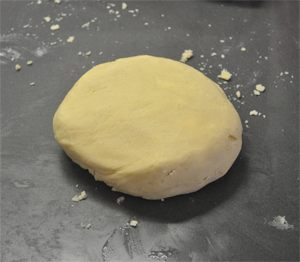

When the pastry has rested, take your baking mat and place it on a tray. Give the mat and rings a quick spritz with baking, 1 cal spray or just grease with butter.
Remove the pastry from the fridge, and unwrap from the cling. Stretch the cling film out, dust the pastry with icing sugar, then place back in the middle. Working really quickly while it's cold, roll the pastry on the cling film to a thickness of about 3mm. Check the width by putting the 4 flan rings on top - you'll need some excess around the edges of each. Cut the pastry into 4 equal pieces.
Remove all but one of the 4 pieces, then use the cling film under the pastry to pick it up, invert and place over one flan ring. Push the pastry into the corners - again, now that the cling is on top, you should be able to do this all by hand without further dusting. When you're happy, carefully peel the cling film off. Make sure any excess pastry is bent and folded over the edges of the case, and that no metal is visible on the upper rim. If it is, cut off some excess dough and push it into place. Sugar pastry is more forgiving than many other types, mainly because you can quite neatly blend any holes with extra pastry.
Repeat with the other four pieces, placing each one back onto the cling, inverting, then pressing in.
Turn your oven on to 170°C.
To help stop shrinkage, freeze the tart cases instead of just putting them in the fridge. Leave it in there for about 30 minutes (not much more - you don't want it to completely solidify) until nice and cold. When you're ready to blind bake, remove the cases from the freezer and place some silver foil (matte side down) into each one. Scrunch it down over the top edges so they are completely covered in foil, then gently pour in your baking beans into each one.
You need to add a bit of extra cooking time due to how cold they are; so bake for about 20 minutes. After this time they should look anaemic but be solid - so carefully remove the foil and beans, then brush with a beaten egg and return to the oven for a further 5 to 10 minutes until golden inside.
Remove and leave to cool to near room temperature, then use a sharp paring knife to trim the outer edge of each one. Carefully remove the rings, then brush out any pastry crumbs.
Make the meringues
 Turn your oven on to 110°C.
Turn your oven on to 110°C.
Beat the egg whites in your stand mixer until soft peaks form - normally less than a minute on a Kitchen Aid up at full whack. Slowly shower in the caster sugar, then leave it running on high for about 5 minutes until you have stiff peaks.
Turn the mixer down to low. Shower in the icing sugar and add the rose flavouring. Give it a quick 30 seconds on high, then turn off and transfer to a piping bag.
Take a baking tray, and place a silicone mat on top. Pipe tall-ish meringues by applying pressure to the bag and pulling upwards. Sprinkle half with crushed pistachio, and half with rose petals.
Place in the pre-heated oven, then cook for 60 minutes.
Make the nougat
Weigh the egg whites into the bowl of a stand mixer and attach the whisk. Line your high sided baking tray with cling film and sprinkle with icing sugar.Place the sugar and liquid glucose in a heavy bottomed pan with a thermometer, and heat to 135°C. At this point, spin up the stand mixer to full and whip the egg whites.
Carefully pour the honey in and heat to 145°C on your thermometer.
When reached, and with the mixer still running, pour the sugar mix onto the egg whites and whip until the mixer bowl feels just warm to the touch. Pour in the pistachios and mix for a moment.
Working quickly before it sets too much, scoop or pour the mix into your tray, sprinkle over some more icing sugar then let set. It will probably only take another 15 minutes.
When set, remove from the cling film and chop into small squares.
Put it all together
Take a tart case, and fill it with rose crème pâtissière right to the edge. Flatten with a spatula.Remove the pistachio cream from the freezer and cut a piece out with your circular cutter. Roll in the crushed nuts, then place on top of the tart case.
Take two pieces of nougat and place those on top of the pistachio disk. Dot over some pistachio butter, then add two or three of each type of meringue. Finally, sprinkle over a few more crushed nuts and some rose petals.
Serve when the cream has thawed - during the summer it will only take about 20 mins at room temp.









